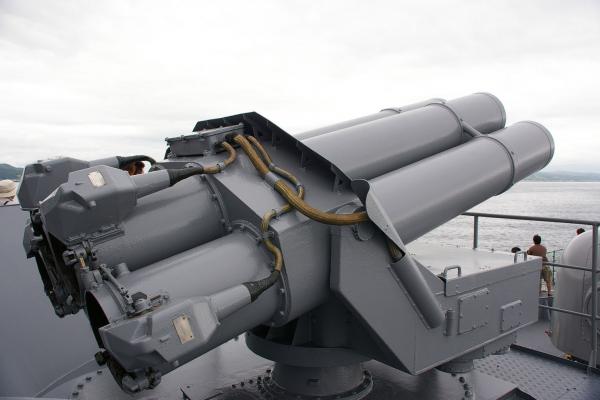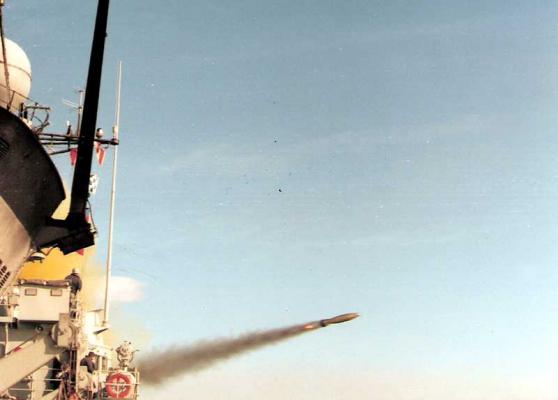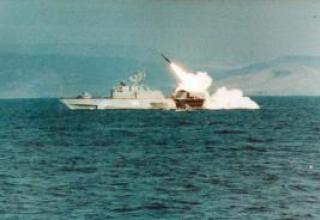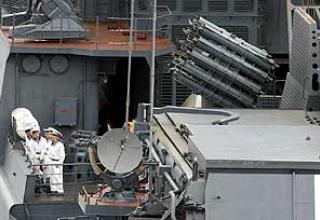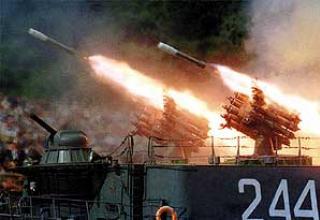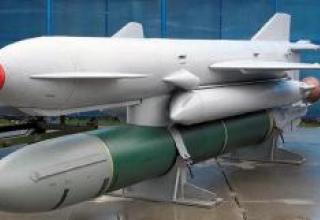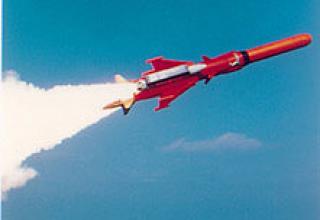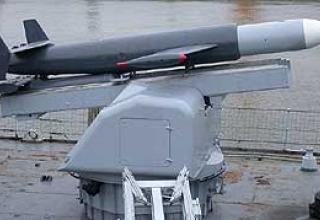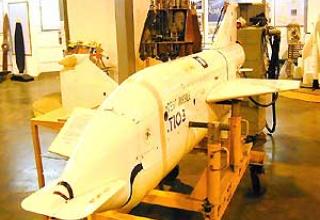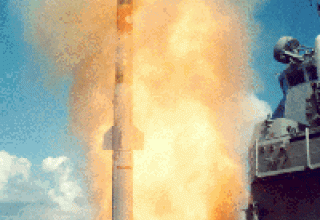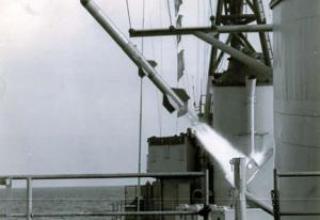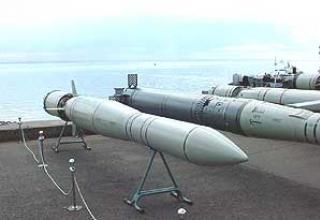The 375mm Bofors Anti-submarine Rocket Complex (RPK) is designed to provide anti-submarine and anti-torpedo defence for surface ships at shallow depths and in coastal waters.
The complex has been developed by the Swedish company Bofors Ordnance since the early 1950s. Tests of the first version of the complex began in 1954, and since 1956 mass production was launched. The complex was positioned as an effective and inexpensive means of self-defense of ships of small displacement from submarines, and as a result it became quite widespread in the naval forces of several countries.
It consisted or is in service with: Belgium (frigates of Wielingen FF class - 3 pcs.), Brazil (frigates of Niteroi FF class - 6 pcs.), Egypt (corvettes of Descubierta FF - 2 pcs.), France (frigates of D'Estienne D'Orves class (A-69) - 17 pcs. ), India (frigates of class Leander FF - 6 units), Indonesia 3 (light frigates Fatahillah FFL - 3 units), Japan (frigates of classes: Minegumo FF - 3 units, Yamagumo FF - 6 units.., Takatsuki FF - 4pcs., Ishikari FF - 1pcs. ; Isuzu FF - 4 pcs.., Yubari FF - 2 pcs.), Malaysia (frigates of class FS 1500 FFL - 2 pcs.), Morocco (frigate of class Descubierta FF - 1 pcs.), Nigeria (light frigates of class Erinmori FFL - 2 pcs.). ), Peru (Friesland DD class destroyers - 8 pcs.), Turkey 4 (Koln FF class frigate - 4 pcs.) and Germany (Hamburg DDG class destroyers - 2 pcs.).
Since 1967, the French company Creusot-Loire under license has been producing four-barrel launcher RPK Bofors under the designation mod 54. It subsequently developed its own mod 72 launcher, which differed from the prototype by having six barrels. In 1968, Mitsubishi entered into a contract with Bofors to manufacture the complex under license for Japanese Navy. Improvement of the complex continued in the direction of development of new means of destruction. Since 1973, the Bofors company started mass production of a new version of the depth-jet bomb, designated Nelli.
At present, despite the old age, the Bofors RPK remains in service. This is due to the need to combat modern diesel-electric and ultra-small submarines in shallow water, i.e. where traditional anti-submarine defenses - homing torpedoes - are ineffective. Another growing need is to provide anti-torpedo defence for ships. Experiments conducted by the Belgian Navy have confirmed that the Bofors RPK can be quite effective against acoustic homing torpedoes. It is expected that a volley of the complex made towards the attacking torpedo will lead to the failure of its homing head.
Composition:
The Bofors RPK is comprised of:
- unguided rockets (bombs),
- launcher,
- charger,
- firing control devices.
The target is detected by the ship's hydroacoustic system, which determines its parameters and transmits them to control units for ballistic firing preparation. The firing control devices produce the angles of horizontal and vertical guidance of the complex launcher. Electric power drives direct the launchers at continuously produced angles and keep them at these angles during firing.
The main sample launcher (see diagram) is the SR375 four-barrel launcher, weighing 7.5 tons. The barrels are mounted on a common rotating platform. The launcher is equipped with electro-hydraulic power drives for guidance and projectile feeding system. Recharging is automatic from the sub deck magazine located directly below the unit. The magazine has a capacity of 8 rounds, the recharging time of the four barrels is 3 minutes. Charging system provides both automatic and manual feeding. Shots are fired in single shots or in volley. The minimum interval between shots in a volley is 1s. The angles of guidance of the launcher in the vertical plane are from 15° to 60° when firing and up to 90° when charging, in the horizontal plane - ±130°. Guidance speed up to 18° per second. Calculation of the complex - 4 people. The area occupied on deck - 1870 x 2220 mm. Ready time of the complex for firing with the charging of the launcher is 90 seconds, ready time of the charged launcher - 60 seconds.
In addition to the four barrel launcher, Bofors Ordnance has produced a series of dual barrel launchers (see photo). The weight has been reduced to 3.98 t and the recharging time has been reduced to 30s.
Unmanned rockets (NURS) of Erika, Flora, Mimmi, Nelli can be used in the complex (see photo). They have the same caliber and length. The main differences between the projectiles are their weight and range. The projectiles are equipped with a solid propellant rocket engine with two concentric combustion chambers, the initiation of fuel charges from combustion chambers in various combinations ensures (together with the guidance of the PU in the vertical plane) overlapping the range of firing ranges. NURS is equipped with hydrostatic and contact fuses. The installation of the hydrostatic fuse is performed to a depth of 250m.
Characteristics:
| Maximum range of fire, m. | 3625 |
| Dimensions of the complex on deck, mm | 1870 х 2220 |
| Depth of target, m | 250 |
| НУРС Erika | |
| Starter weight, kg | 107 |
| Range of fire, m: - minimum - maximum |
655 1635 |
| Flight Speed, m/s | 10.7 |
| НУРС Flora | |
| Starter weight, kg | 242 (230) |
| Range of fire, m: - minimum - maximum |
1400 2230 |
| Flight Speed, m/s | 10.2 |
| НУРС Mimmi | |
| Starter weight, kg | 100 |
| Range of fire, m: - minimum - maximum |
370 875 |
| Flight Speed, m/s | 10.9 |
| НУРС Nelli | |
| Starter weight, kg | 230 |
| Range of fire, m: - minimum - maximum |
1580 3625 |
| Flight Speed, m/s | 9.2 |
Testing:
As of 01.01.1950, in July 1949 the projectile successfully passed the state tests.
At the time of drawing up the document at the factories of gross production was producing a batch of shells for military tests.
According to data from 1977, the specialists of the Israel Military Industries (Israel Military Industries) developed a 240 mm projectile designed to fire a 12-charged war machine (launcher).
The body of the combat vehicle (combat unit) was manufactured by forging method with high precision machining. When the combat unit is torn, about 1,200 steel fragments with a 12,000-square-metre chima killer will break off. When 12 rounds are fired in volley at a range of 10,000 square metres, an area of 125,000 square metres is hit. A circular variation of 0.8% of the range is possible.
The turbojet projectile can be equipped with an instant or slow motion fuse (0.5 second deceleration). A non-contact fuse may be fitted if required.
The engine is designed with 16 nozzles (nozzle openings), after which the combustion products are allowed to rotate to stabilize the projectile. It also includes seven solid fuel draughts and an electric ignition mechanism. The pressure in the combustion chamber is 150 atm; the traction force is 4000 kg, the combustion time is 1.2 s and the total impulse is 4800 kg/s.
Main characteristics of the projectile
| Length | 1290 mm |
| Weight, kg: | |
| shell | |
| full | 110,5 |
| after a fuel burnout | 85,8 |
| combat unit | 30 |
| BB (TNT) | 18,3 |
| fuels | 24 |
| Firing range, m (at an elevation angle of 45°) | 10 700 |
| Shot rate, m/s. | |
| initial | 40 |
| at the end of a fuel burn | 400 |
| when faced with an obstacle | 270 |
For storage and transportation, the projectile is placed in a polystyrene container, the fuses are placed in wooden containers.
